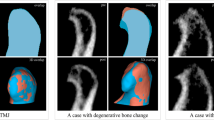Abstract
The aim of this study was to investigate the association between condylar bone morphological characteristics with occlusal conditions. Besides the study will compare the tomography images with the real condition in 122 temporomandibular joints from 61 skulls. The occlusal conditions were evaluated by number of teeth missing, measurement of overjet and overbite, in millimeters, and presence or absence of crossbite, openbite and dental rotation. The condylar bone morphological conditions were classified in five types (normal, presence of erosion, presence of osteophytes, flattening and/or deformation). This classification was used in real skulls and in Cone Beam Computed tomography (CBCT) images. The data were submitted to statistical analysis with a level of significance of 0.05. Occlusal variables have no association to morphologic data (p > 0.05). Normal condylar bone was seen in 62 CBCT versus 53 in real skulls while morphological alterations were seen in 60 CBCT versus 67-real condyles. The clinical and tomographic measurements were compared, demonstrating an important difference in the classification demonstrating poor association between detection methods (k − 0.3, p < 0.001). The occlusal conditions appear to have no correlation with the morphological condyle conditions. The CBCT is a reliable diagnostic method, although it may present divergences of findings when compared with clinical raw examination to morphologic condylar conditions.





Similar content being viewed by others
References
Alomar X, Medrano J, Cabratosa J et al (2007) Anatomy of temporomandibular joint. Semin Ultrasound CT MRI 28:70–183
Burke G, Major P, Glover K, Prasad N (1998) Correlations between condylar characteristics and facial morphology in Class II preadolescent patients. Am J Orthod Dentofac Orthop 114(3):328–336
Valladares-Neto J, Estrela C, Bueno MR, Guedes OA, Porto OCL, Pécora JD (2010) Mandibular condyle dimensional changes in subjects from 3 to 20 years of age using Cone-Beam Computed Tomography: a preliminary study. Dental Press J Orthod 15:172–181. https://doi.org/10.1590/S2176-94512010000500021
Rodrigues AF, Fraga MR, Vitral RW (2009) Computed tomography evaluation of the temporomandibular joint in Class I malocclusion patients: condylar symmetry and condyle-fossa relationship. Am J Orthod Dentofac Orthop 136(20):192–198. https://doi.org/10.1016/j.ajodo.2007.07.033
Bailey AJ, Knott L (1999) Molecular changes in bone collagen in osteoporosis and osteoartthritis in the elderly. Exp Gerontol 34:337–351
Romanblas JA, Castaneda S, Largo R, Lems WF, Herrero-Beaumont G (2014) An OA phenotype may obtain major benefit from bone-acting agents. Semin Arthritis Rheum 43:421–428. https://doi.org/10.1016/j.semarthrit.2013.07.012
Manzione JV, Katzberg RW, Brodsky GL, Seltzer SE, Mellins HZ (1984) Internal derangements of the temporomandibular joint: diagnosis by direct sagittal computed tomography. Radiology 15:111–115. https://doi.org/10.1148/radiology.150.1.6689751
dos Anjos Pontual ML, Freire JSL, Barbosa JMN, Frazão MAG, dos Anjos Pontual A, Fonseca da Silveira MM (2012) Evaluation of bone changes in the temporomandibular joint using cone beam CT. Dentomaxillofac Radiol 41:24–29. https://doi.org/10.1259/dmfr/17815139
Uemura S, Nakamura M, Iwakasi H, Fuchihata H (1979) A roentgenologival study on temporomandibular joint disorders. Morphological changes of TMJ in arthrosis. Dent Radiol 19:224–237. https://doi.org/10.11242/dentalradiology1960.19.224
Brothwell DR (1981) Digging up bones, 1st edn. Cornell University Press, New York
Katzenberg MA, Saunders SR (2002) Biological anthropology of the human skeleton, 1st edn. Wiley, New York
Karadag D, Ozdol NC, Beriat K, Akinci T (2011) CT evaluation of the bony nasal pyramid dimensions in Anatolian people. Dentomaxillofac Radiol 40(3):160–164
Anjun S, Khan NA, Ahmad M (2014) Frequency, cause and effects of temporomandibular dysfunction syndrome among patients seen at Nishtar Institute of Dentistry. Pak Oral Dent J 84(1):54–56
Arafa KA (2016) The effects of clinical wear of the incidence of temporomandibular disorders among patients with complete dentures. J Taibah Univ Sci 11(3):250–254. https://doi.org/10.1016/j.jtumed.2016.04.005
Dallanora AF, Grasel CE, Heine CP et al (2012) Prevalence of temporomandibular disorders in a population of complete denture wearers. Gerodontology 29(2):865–869. https://doi.org/10.1111/j.1741-2358.2011.00574.x
Luo X, Long M, Deng Q (2016) Association of COL 1A1 polymorphism with subchondral bone degeneration of the temporomandibular joint. Int J Oral Maxillofac Surg 45(12):1551–1555. https://doi.org/10.1016/j.ijom.2016.06.010
Author information
Authors and Affiliations
Corresponding author
Ethics declarations
Ethical approval
All applicable institutional guidelines for the care and use of skulls were followed.
Informed consent
For this type of study, formal consent is not required.
Rights and permissions
About this article
Cite this article
Scariot, R., Corso, P., Gonsar, B. et al. TMJ arthrosis: does the occlusal relationship really interfere? A comparison between cone beam computed tomography and dried skulls. Surg Radiol Anat 41, 469–476 (2019). https://doi.org/10.1007/s00276-018-2167-1
Received:
Accepted:
Published:
Issue Date:
DOI: https://doi.org/10.1007/s00276-018-2167-1




